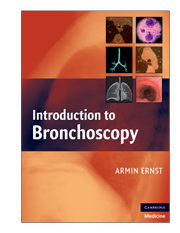Book contents
- Frontmatter
- Contents
- Contributors
- Introduction
- Abbreviations/Acronyms
- 1 A Short History of Bronchoscopy
- 2 Multidetector Computed Tomography Imaging of the Central Airways
- 3 The Larynx
- 4 Airway Anatomy for the Bronchoscopist
- 5 Anesthesia for Bronchoscopy
- 6 Anatomy and Care of the Bronchoscope
- 7 Starting and Managing a Bronchoscopy Unit
- 8 Flexible Bronchoscopy: Indications, Contraindications, and Consent
- 9 Bronchial Washing, Bronchoalveolar Lavage, Bronchial Brush, and Endobronchial Biopsy
- 10 Transbronchial Lung Biopsy
- 11 Transbronchial Needle Aspiration
- 12 Bronchoscopy in the Intensive Care Unit
- 13 Bronchoscopy in the Lung Transplant Patient
- 14 Advanced Diagnostic Bronchoscopy
- 15 Basic Therapeutic Techniques
- Index
- References
15 - Basic Therapeutic Techniques
Published online by Cambridge University Press: 07 July 2009
- Frontmatter
- Contents
- Contributors
- Introduction
- Abbreviations/Acronyms
- 1 A Short History of Bronchoscopy
- 2 Multidetector Computed Tomography Imaging of the Central Airways
- 3 The Larynx
- 4 Airway Anatomy for the Bronchoscopist
- 5 Anesthesia for Bronchoscopy
- 6 Anatomy and Care of the Bronchoscope
- 7 Starting and Managing a Bronchoscopy Unit
- 8 Flexible Bronchoscopy: Indications, Contraindications, and Consent
- 9 Bronchial Washing, Bronchoalveolar Lavage, Bronchial Brush, and Endobronchial Biopsy
- 10 Transbronchial Lung Biopsy
- 11 Transbronchial Needle Aspiration
- 12 Bronchoscopy in the Intensive Care Unit
- 13 Bronchoscopy in the Lung Transplant Patient
- 14 Advanced Diagnostic Bronchoscopy
- 15 Basic Therapeutic Techniques
- Index
- References
Summary
INTRODUCTION
Interventional pulmonology is an evolving discipline stemming from pulmonary medicine that concentrates on both diagnostic and therapeutic interventions for patients with advanced airway and pleural diseases. The interventional pulmonologist has taken an active role in developing potentially less invasive ways to perform diagnostic and therapeutic procedures in disorders of the airway and pleura.
Procedures encompassed within this expanding field include, but are not limited to, rigid bronchoscopy, endobronchial laser therapy, electrocautery, cryotherapy, balloon dilation (BD), brachytherapy (BT), and endotracheal or endobronchial stent placement. The question of which modality to use is influenced by many factors, including patient presentation, operator proficiency, anesthetic techniques, and the institution's available equipment. The key to success in caring for patients with these disorders is careful patient selection and the complementary application of these techniques. In this review we will focus on describing these procedures, as well as outlining an active approach to the clinical disorders for which they are used.
CENTRAL AIRWAYS OBSTRUCTION
Obstruction or stenosis of the trachea and large bronchi can be a consequence of endobronchial obstruction, extraluminal compression, or a combination of both. Endoluminal or endobronchial lesions are most common. Extrinsic compression causing obstruction of the airway is less frequent, but can result in symptoms and outcomes similar to those of endobronchial obstruction. Most cases are secondary to bronchogenic carcinoma; however, both benign and malignant causes can produce significant morbidity and decreased life expectancy if left untreated. Table 15.1 shows the common etiologies of central airway obstruction.
Information
- Type
- Chapter
- Information
- Introduction to Bronchoscopy , pp. 142 - 150Publisher: Cambridge University PressPrint publication year: 2009
